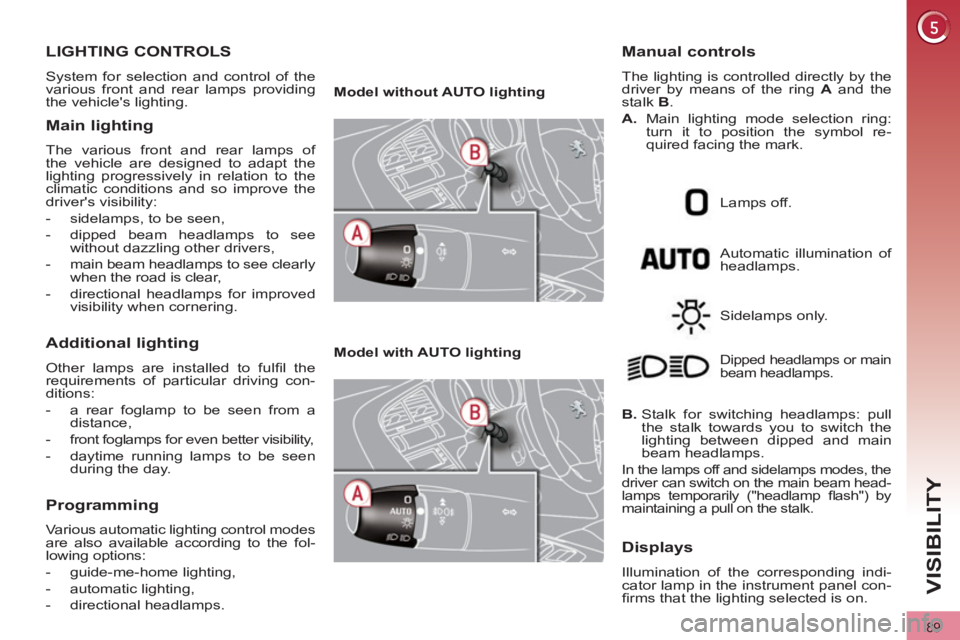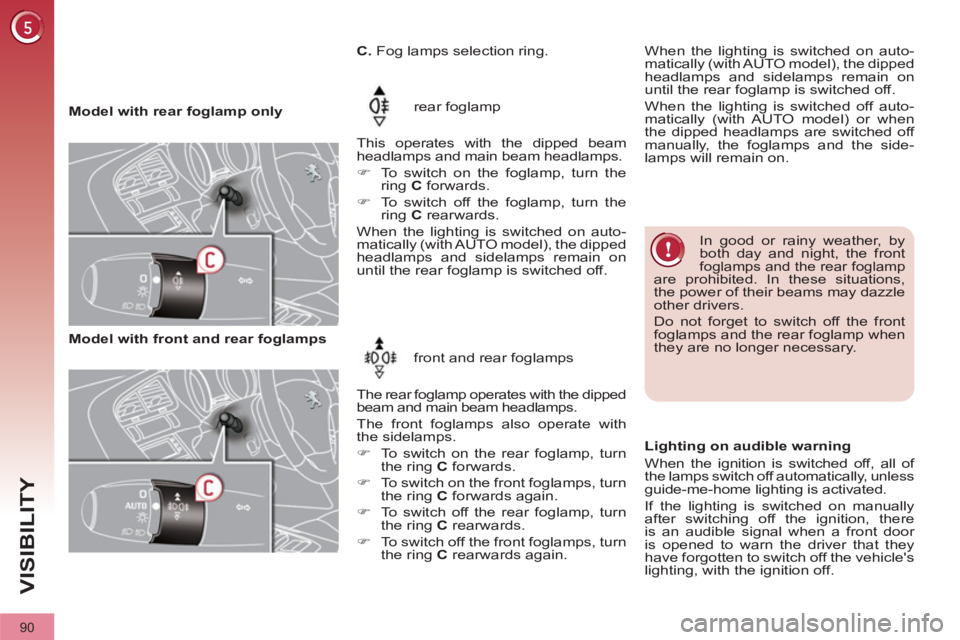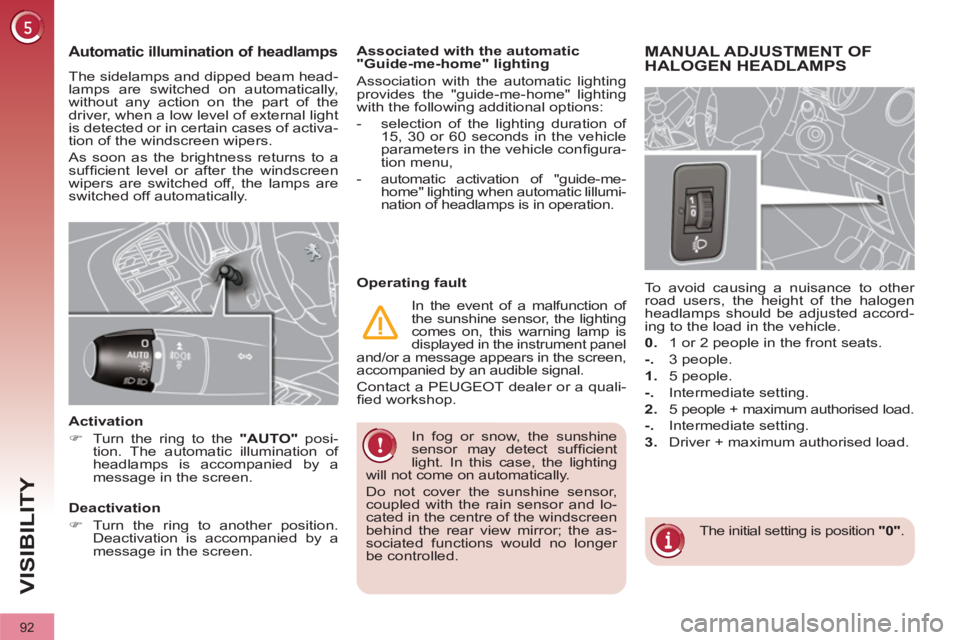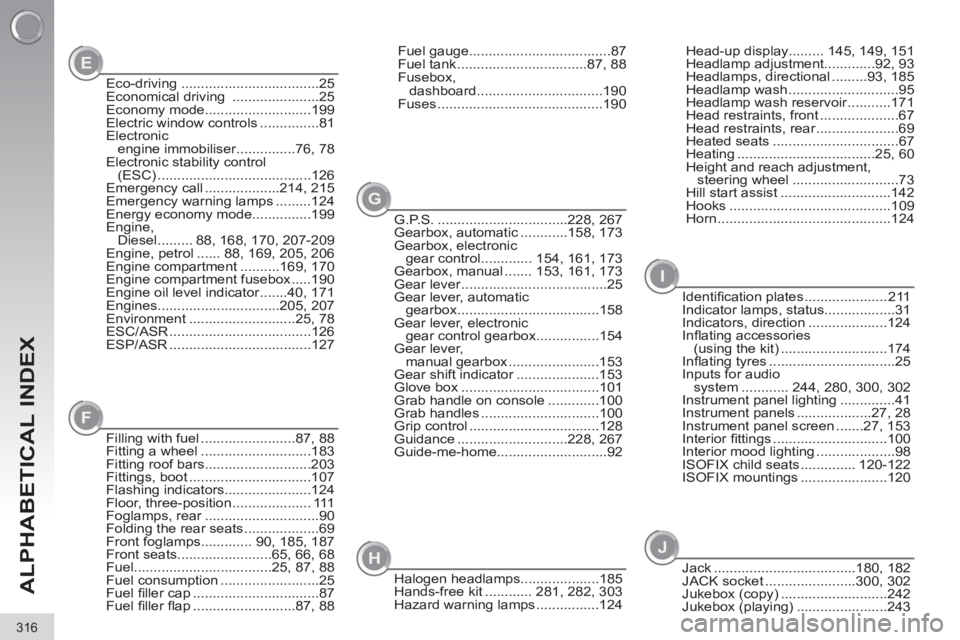2011 PEUGEOT 308 fog light
[x] Cancel search: fog lightPage 16 of 328

14
FAMILIARISATION
SEEING CLEARLY
Lighting
Ring A
Lighting off.
Ring B Sidelamps.
Dipped/main beam headlamps.
Rear foglamp.
or
Front and rear foglamps. Automatic illumination of head-
lamps.
89
Direction indicators
Raise or lower the lighting stalk passing
the point of resistance; the correspond-
ing direction indicators will fl ash for as
long as the stalk remains in this position.
"Motorway" function
Press the lighting stalk up or down once,
without passing the point of resistance;
the corresponding direction indicators
will fl ash three times.
This function can be used at any speed,
but it is particularly useful when chang-
ing lane on high-speed roads.
124
Wipers
Stalk A: windscreen wipers
Switching on "AUTO"
�)
Press the stalk down and release it.
Switching off "AUTO"
�)
Push the stalk up and return it to po-
sition "0"
.
94
Ring B: rear wiper
Park.
Intermittent wipe.
Wash-wipe.
95
Page 27 of 328

Optimise the use of your
gearbox
With a manual gearbox, move off gen-
tly, change up without waiting and
drive by changing up quite soon. If
your vehicle has the system, the gear
shift indicator invites you to change up;
it is displayed in the instrument panel,
follow its instructions.
With an automatic or electronic gear-
box, stay in Drive "D"
or Auto "A"
, ac-
cording to the type of gearbox, without
pressing the accelerator pedal heavily
or suddenly.
Drive smoothly
Maintain a safe distance between vehi-
cles, use engine braking rather than the
brake pedal, and press the accelerator
progressively. These practices contrib-
ute towards a reduction in fuel consump-
tion and CO
2 emissions and also helps
reduce the background traffi c noise.
If your vehicle has cruise control, make
use of the system at speeds above
25 mph (40 km/h) when the traffi c is
fl owing well.
Control the use of your electrical equipment
Before moving off, if the passenger
compartment is too warm, ventilate it by
opening the windows and air vents be-
fore using the air conditioning.
Above 30 mph (50 km/h), close the win-
dows and leave the air vents open.
Remember to make use of equipment
that can help keep the temperature in
the passenger compartment down (sun
roof and window blinds...).
Switch off the air conditioning, unless
it has automatic digital regulation, as
soon as the desired temperature is at-
tained.
Switch off the demisting and defrosting
controls, if not automatic.
Switch off the heated seat as soon as
possible.
Switch off the headlamps and front
foglamps when the level of light does
not require their use.
Avoid running the engine before moving
off, particularly in winter; your vehicle will
warm up much faster while driving.
As a passenger, if you avoid connecting
your multimedia devices (fi lm, music,
video game...), you will contribute to-
wards limiting the consumption of elec-
trical energy, and so of fuel.
Disconnect your portable devices be-
fore leaving the vehicle.
ECO-DRIVING
25
Eco-driving is a range of everyday practices that allow the motorist to optimise their fuel consumption and CO2 emis-
sions.
Page 32 of 328

30
INSTRUMENTS and CONTROLS
Operation indicator lamps
If one of the following indicator lamps comes on, this confi rms that the corresponding system has come into operation.
Warning lamp
is on
Cause
Action/Observations
Left-hand
direction
indicato
r
fl ashing
with buzzer. The lighting stalk is pushed
down.
Right-hand
direction
indicator
fl ashing
with buzzer. The lighting stalk is pushed
up.
Sidelamps
fi xed. The lighting stalk is in the
"Sidelamps" position.
Dipped beam
headlamps
fi xed. The lighting stalk is in the
"Dipped beam headlamps"
position.
Main beam
headlamps
fi xed. The lighting stalk is pulled
towards you. Pull the stalk to return to dipped beam
headlamps.
Front
foglamps
fi xed. The front foglamps are
switched on. Turn the ring on the stalk rearwards twice to
switch off the front foglamps.
Rear
foglamps
fi xed. The rear foglamps are
switched on. Turn the ring on the stalk rearwards to switch off
the rear foglamps.
Page 91 of 328

89
VISIBILITY
LIGHTING CONTROLS
System for selection and control of the
various front and rear lamps providing
the vehicle's lighting.
Main lighting
The various front and rear lamps of
the vehicle are designed to adapt the
lighting progressively in relation to the
climatic conditions and so improve the
driver's visibility:
- sidelamps, to be seen,
- dipped beam headlamps to see
without dazzling other drivers,
- main beam headlamps to see clearly
when the road is clear,
- directional headlamps for improved
visibility when cornering.
Additional lighting
Other lamps are installed to fulfi l the
requirements of particular driving con-
ditions:
- a rear foglamp to be seen from a
distance,
- front foglamps for even better visibility,
- daytime running lamps to be seen
during the day.
Programming
Various automatic lighting control modes
are also available according to the fol-
lowing options:
- guide-me-home lighting,
- automatic lighting,
- directional headlamps.
Model without AUTO lighting
Model with AUTO lighting
Automatic illumination of
headlamps.
Manual controls
The lighting is controlled directly by the
driver by means of the ring A
and the
stalk B
.
A.
Main lighting mode selection ring:
turn it to position the symbol re-
quired facing the mark.
Lamps off.
Sidelamps only.
B.
Stalk for switching headlamps: pull
the stalk towards you to switch the
lighting between dipped and main
beam headlamps.
In the lamps off and sidelamps modes, the
driver can switch on the main beam head-
lamps temporarily ("headlamp fl ash") by
maintaining a pull on the stalk.
Dipped headlamps or main
beam headlamps.
Displays
Illumination of the corresponding indi-
cator lamp in the instrument panel con-
fi rms that the lighting selected is on.
Page 92 of 328

90
VISIBILITY
Model with rear foglamp only rear foglamp
This operates with the dipped beam
headlamps and main beam headlamps.
�)
To switch on the foglamp, turn the
ring C
forwards.
�)
To switch off the foglamp, turn the
ring C
rearwards.
When the lighting is switched on auto-
matically (with AUTO model), the dipped
headlamps and sidelamps remain on
until the rear foglamp is switched off.
In good or rainy weather, by
both day and night, the front
foglamps and the rear foglamp are prohibited. In these situations,
the power of their beams may dazzle
other drivers.
Do not forget to switch off the front
foglamps and the rear foglamp when
they are no longer necessary.
Model with front and rear foglamps
front and rear foglamps
The rear foglamp operates with the dipped
beam and main beam headlamps.
The front foglamps also operate with
the sidelamps.
�)
To switch on the rear foglamp, turn
the ring C
forwards.
�)
To switch on the front foglamps, turn
the ring C
forwards again.
�)
To switch off the rear foglamp, turn
the ring C
rearwards.
�)
To switch off the front foglamps, turn
the ring C
rearwards again.
C.
Fog lamps selection ring.
Lighting on audible warning
When the ignition is switched off, all of
the lamps switch off automatically, unless
guide-me-home lighting is activated.
If the lighting is switched on manually
after switching off the ignition, there
is an audible signal when a front door
is opened to warn the driver that they
have forgotten to switch off the vehicle's
lighting, with the ignition off.
When the lighting is switched on auto-
matically (with AUTO model), the dipped
headlamps and sidelamps remain on
until the rear foglamp is switched off.
When the lighting is switched off auto-
matically (with AUTO model) or when
the dipped headlamps are switched off
manually, the foglamps and the side-
lamps will remain on.
Page 94 of 328

92
VISIBILITY
In fog or snow, the sunshine
sensor may detect suffi cient
light. In this case, the lighting
will not come on automatically.
Do not cover the sunshine sensor,
coupled with the rain sensor and lo-
cated in the centre of the windscreen
behind the rear view mirror; the as-
sociated functions would no longer
be controlled.
Associated with the automatic
"Guide-me-home" lighting
Association with the automatic lighting
provides the "guide-me-home" lighting
with the following additional options:
- selection of the lighting duration of
15, 30 or 60 seconds in the vehicle
parameters in the vehicle confi gura-
tion menu,
- automatic activation of "guide-me-
home" lighting when automatic lillumi-
nation of headlamps is in operation.
Automatic illumination of headlamps
The sidelamps and dipped beam head-
lamps are switched on automatically,
without any action on the part of the
driver, when a low level of external light
is detected or in certain cases of activa-
tion of the windscreen wipers.
As soon as the brightness returns to a
suffi cient level or after the windscreen
wipers are switched off, the lamps are
switched off automatically.
Activation
�)
Turn the ring to the "AUTO"
posi-
tion. The automatic illumination of
headlamps is accompanied by a
message in the screen.
Deactivation
�)
Turn the ring to another position.
Deactivation is accompanied by a
message in the screen.
Operating fault
In the event of a malfunction of
the sunshine sensor, the lighting
comes on, this warning lamp is
displayed in the instrument panel
and/or a message appears in the screen,
accompanied by an audible signal.
Contact a PEUGEOT dealer or a quali-
fi ed workshop.
MANUAL ADJUSTMENT OF
HALOGEN HEADLAMPS
The initial setting is position "0"
.
To avoid causing a nuisance to other
road users, the height of the halogen
headlamps should be adjusted accord-
ing to the load in the vehicle.
0.
1 or 2 people in the front seats.
-.
3 people.
1.
5 people.
-.
Intermediate setting.
2.
5 people + maximum authorised load.
-.
Intermediate setting.
3.
Driver + maximum authorised load.
Page 318 of 328

E
G
F
H
I
J
316
ALPHABETICAL INDEX
Eco-driving ...................................25
Economical driving ......................25
Economy mode...........................199
Electric window controls ...............81
Electronic
engine immobiliser ...............76, 78
Electronic stability control
(ESC) .......................................126
Emergency call ...................214, 215
Emergency warning lamps .........124
Energy economy mode...............199
Engine,
Diesel ......... 88, 168, 170, 207-209
Engine, petrol ...... 88, 169, 205, 206
Engine compartment ..........169, 170
Engine compartment fusebox .....190
Engine oil level indicator .......40, 171
Engines...............................205, 207
Environment ...........................25, 78
ESC/ASR ....................................126
ESP/ASR ....................................127G.P.S. .................................228, 267
Gearbox, automatic ............158, 173
Gearbox, electronic
gear control ............. 154, 161, 173
Gearbox, manual ....... 153, 161, 173
Gear lever .....................................25
Gear lever, automatic
gearbox ....................................158
Gear lever, electronic
gear control gearbox ................154
Gear lever,
manual gearbox .......................153
Gear shift indicator .....................153
Glove box ...................................101
Grab handle on console .............100
Grab handles ..............................100
Grip control .................................128
Guidance ............................228, 267
Guide-me-home............................92 Filling with fuel ........................87, 88
Fitting a wheel ............................183
Fitting roof bars...........................203
Fittings, boot ...............................107
Flashing indicators......................124
Floor, three-position .................... 111
Foglamps, rear .............................90
Folding the rear seats ...................69
Front foglamps............. 90, 185, 187
Front seats........................65, 66, 68
Fuel...................................25, 87, 88
Fuel consumption .........................25
Fuel fi ller cap ................................87
Fuel fi ller fl ap ..........................87, 88Fuel gauge....................................87
Fuel tank .................................87, 88
Fusebox,
dashboard ................................190
Fuses ..........................................190
Halogen headlamps....................185
Hands-free kit ............ 281, 282, 303
Hazard warning lamps ................124Head-up display......... 145, 149, 151
Headlamp adjustment.............92, 93
Headlamps, directional .........93, 185
Headlamp wash ............................95
Headlamp wash reservoir ...........171
Head restraints, front ....................67
Head restraints, rear .....................69
Heated seats ................................67
Heating ...................................25, 60
Height and reach adjustment,
steering wheel ...........................73
Hill start assist ............................142
Hooks .........................................109
Horn ............................................124
Identifi cation plates ..................... 211
Indicator lamps, status..................31
Indicators, direction ....................124
Infl ating accessories
(using the kit) ...........................174
Infl ating tyres ................................25
Inputs for audio
system ............ 244, 280, 300, 302
Instrument panel lighting ..............41
Instrument panels ...................27, 28
Instrument panel screen .......27, 153
Interior fi ttings .............................100
Interior mood lighting ....................98
ISOFIX child seats .............. 120-122
ISOFIX mountings ......................120
Jack ....................................180, 182
JACK socket .......................300, 302
Jukebox (copy) ...........................242
Jukebox (playing) .......................243
Page 319 of 328

NP
K
L
M
O
R
317
ALPHABETICAL INDEX
Navigation...........................228, 267
Number plate lamps ...................189Paint colour code ........................ 211
Panoramic glass sunroof ............106
Parking brake .............................173
Parking brake, electric ........137, 140
Parking sensors, rear .................164
Particle emission fi lter.........172, 173
Passenger compartment fi lter.....172
PEUGEOT call button .................215
PEUGEOT CONNECT
ASSISTANCE ..........................214
Peugeot Connect Media Navigation
(NG4 3D) ............... 28, 51, 53, 55,
217, 220, 223, 224, 226, 251
Peugeot Connect Navigation
(RNEG) ............... 49, 53, 264, 285
PEUGEOT CONNECT
SOS .................................214, 215
Peugeot Connect Sound
(RD5) ................ 46, 293, 308, 310
PEUGEOT services ....................215
PIN code .....................................248
Player, CD MP3 ..................279, 299
POIs (updating) ..........................235
Port, USB................... 102, 300, 302
Priming the fuel system ..............168
Protecting
children ..... 113, 118, 120-122, 133
Puncture .....................................174 Keeping children
safe .................. 113, 121, 122, 133
Key with remote control .... 74-76, 78Mat..............................................103
Menu, main .................................296
Mini fuel level ................................87
Mirror, rear view ............................72
Mirrors, door .................................71
Misfuel prevention ........................88
Motorway function (direction
indicators) ................................124
Mountings for ISOFIX seats .......120
MP3 CD ..............................279, 299
Multimedia, rear ..........................104
Music media players ...........240, 278
Labels, identifi cation ................... 211
Lamps, warning
and indicator ..................29, 32, 33
Level, brake fl uid ........................171
Level, headlamp wash ..........95, 171
Level, power steering fl uid ..........171
Levels and checks .............. 169-172
Lighting .........................................99
Lighting, guide-me home ........91, 92
Lighting, interior ......................97, 98
Lighting bulbs
(replacement) ......... 185, 188, 189
Lighting control stalk .....................89
Lighting dimmer ............................41
Loading .................................25, 203
Load reduction mode ..................199
Load space cover .......................108
Locating your vehicle ....................75
Locking from the inside.................84
Long objects, transporting ....68, 105
Luggage retaining net .................109
Luggage retaining strap ..............107
Main beam .................... 89, 185-187
Maintenance .................................25
Map reading lamps .......................97
Markings, identifi cation ............... 211Oil fi lter .......................................172
Oil level .................................40, 171
Opening the bonnet ....................167
Opening the boot ....................74, 85
Opening the doors ..................74, 83
Opening the panoramic
sunroof blind ............................106
Opening the retractable
screen ........................................53
Opening the tailgate ...............85, 86
Operation
indicator lamps ....... 29, 31, 32, 34Radio ......................... 239, 277, 297
RCA sockets ...............................244
Reading lamps, rear .....................97
Rear foglamp ......................188, 189
Rear screen (demisting) ...............61
Recharging the battery ...............197